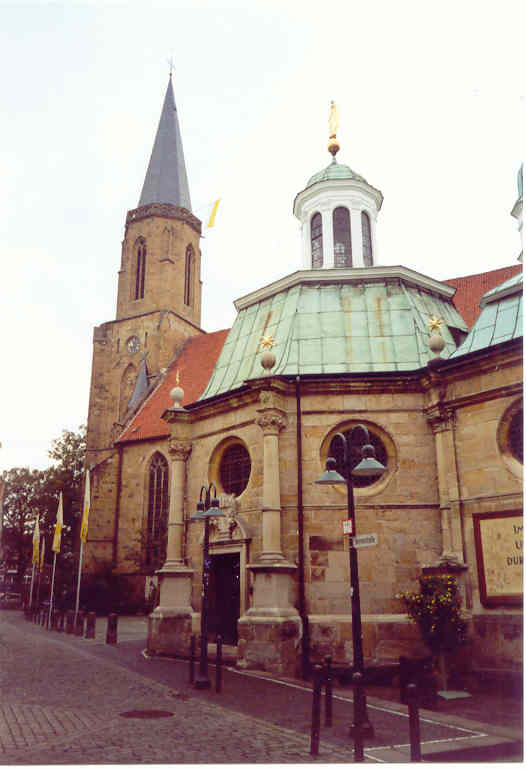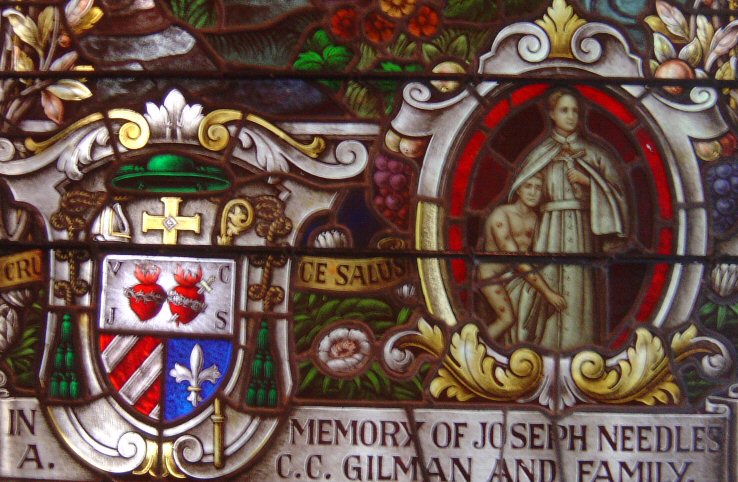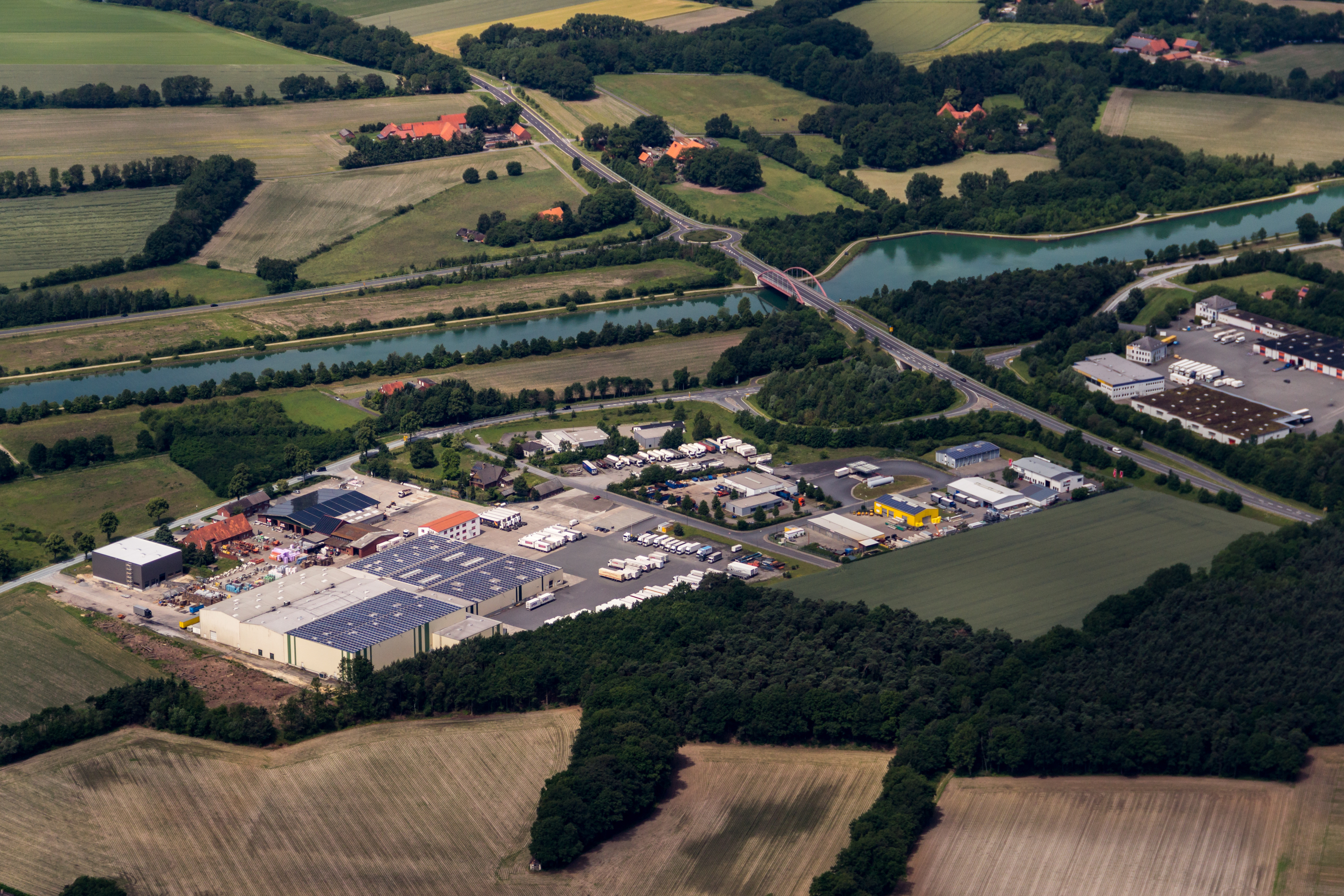|
Ostbevern
Ostbevern is a municipality in the district of Warendorf, in North Rhine-Westphalia, Germany. Geography Ostbevern is situated on the river Bever, approx. 18 km north-east of Münster and 18 km north-west of Warendorf. Neighbouring municipalities Ostbevern borders Ladbergen, Lienen, Glandorf (in Lower Saxony), Warendorf, Telgte and Greven. Division of the town The municipality Ostbevern consists of the village Ostbevern, the district Brock and the surrounding farming land. History In 1088 Bevern was first mentioned in an official document under the name ''Beverne''. Presumably in the 12th century the parish Bevern was split into Ostbevern and Westbevern (which is now part of Telgte). During the Napoleonic Wars the municipality first fell to Prussia, then to Berg. Since 1810 it then belonged to the French Empire, until Ostbevern was assigned to prussia again at the Congress of Vienna. Since World War II Ostbevern lies in North Rhine-Westphalia. Politics Communal ... [...More Info...] [...Related Items...] OR: [Wikipedia] [Google] [Baidu] |
Telgte
Telgte (German pronunciation: tÉlktÉ regionally tÉlçtÉ is a town in the Warendorf district, North Rhine-Westphalia, Germany, on the river Ems 12 km east of Münster and 15 km west of Warendorf. Telgte is famous as a place of pilgrimage, the Marian pilgrimage from Osnabrück to Telgte. Geography Neighboring Communities Telgte borders the cities Münster, Geven, Ostbevern, Warendorf, and Everswinkel. City Districts Telgte divides into the main city and two districts, Westbevern-Dorf and Westbevern-Vadrup. Until 1974, Westbevern (population: about 4000; area of 24,46 km²) was an independent town, with Dorf, Vadrup, and Brock as its districts. Since the reform of the municipal area reform, Brock has been a part of the neighboring town Ostbevern. The Bever runs as a tributary to the Ems through Westbevern. With its double-mill at the Bever, Haus Langen is a popular destination for tourists. For a couple of years, the neo-gothic church St Cornelius ... [...More Info...] [...Related Items...] OR: [Wikipedia] [Google] [Baidu] |
Herman Koeckemann
Herman Koeckemann, formally Bernard Hermann Koeckemann, SS.CC., (January 10, 1828 – February 22, 1892), served as the second vicar apostolic of the Vicariate Apostolic of the Sandwich Islands — now the Roman Catholic Diocese of Honolulu — from 1881 to 1892. Biography Born in Ostbevern, Westphalia, Germany, he was baptized as Bernard. At the age of 14, his father, a farmer, sent him to the Gymnasium of Münster. Koeckemann was an excellent student and excelled in classical studies. During his seven years of college, his progress in Latin, Greek, Hebrew and French and in philosophy and science was so well marked that at the graduation, his examiners dispensed with the oral examination as superfluous. Believing himself called to religious life, he went to Leuven and entered the Congregation of the Sacred Hearts of Jesus and Mary. After a novitiate of eighteen months, he was admitted to religious profession on April 11, 1851, taking the name Herman. After three ... [...More Info...] [...Related Items...] OR: [Wikipedia] [Google] [Baidu] |
Joseph Annegarn
Joseph Annegarn (13 October 1794 at Ostbevern in Westphalia â 8 July 1843 at Braunsberg, East Prussia East Prussia ; german: OstpreiÃen, label=Low Prussian; pl, Prusy Wschodnie; lt, Rytų PrÅ«sija was a province of the Kingdom of Prussia from 1773 to 1829 and again from 1878 (with the Kingdom itself being part of the German Empire from 187 ..., was a German Catholic theologian, professor of church history and popular writer. Works His ''Allgemeine Weltgeschichte für die katholische Jugend'' ("Universal History")Allgemeine Weltgeschichte (Muenster, 1899), 8 vols., 8th ed.; Compendium (1898), 3 vols., 2d ed. was written primarily for Catholic youth, and published in eight volumes in 1827â29. His purpose was frankly Catholic. It became a standard work in Catholic families in Germany, Features of the History are the numerous character sketches of historical personages and the chronological tables. Succeeding editors kept it abreast with historical research. Annegarn w ... [...More Info...] [...Related Items...] OR: [Wikipedia] [Google] [Baidu] |
Ladbergen
Ladbergen is a municipality in the district of Steinfurt, in North Rhine-Westphalia, Germany. It is situated near the Dortmund-Ems Canal, approximately 25 km south-west of Osnabrück and 20 km north-east of Münster. Geography The municipality is situated in the Tecklenburg country in the middle between the cities Münster and Osnabrück. Because of its central location between these two cities Ladbergen is well accessible by the ''Autobahn'' (motorway/freeway) A 1 (Ladbergen junction) and the ''BundesstraÃe'' (federal highway) B 475. The Dortmund-Ems Canal (canal port Ladbergen) situated on the western municipal border and Münster Osnabrück International Airport (FMO) are located a few kilometers from the centre of Ladbergen. Unlike the name part of "bergen" suggests, Ladbergen offers no mountainous or hilly landscape, but is situated at a relatively uniform level between and with a mean elevation of above sea level. Two streams flow through Ladbergen, the La ... [...More Info...] [...Related Items...] OR: [Wikipedia] [Google] [Baidu] |
Greven
Greven (; Westphalian: ''Graiwen'') is a medium-sized town in the district of Steinfurt, in Germany's most populous state of North Rhine-Westphalia and close to the city of Münster. Geography Greven is situated on the river Ems, approx. 25 km south-east of Rheine and 15 km north of Münster. Division of the town Greven consists of the following districts * Greven * Reckenfeld * Gimbte * Schmedehausen Neighbouring municipalities Transport Airport Greven is home to North Rhine-Westphalia's fourth-largest airport Münster Osnabrück International Airport (IATA code: FMO) transporting approx. 2.5 mil. passengers in 2009, but only 1.2 mil. in 2012 to destinations in Europe, Asia Minor, and North Africa. Railway * Regional express trains (''Regional Express'') - these trains do not stop at all stations: ** Emden (north sea)-Leer(Ostfriesland)-Meppen-Lingen(Emsland)-Rheine-Greven-Münster Hauptbahnhof (Main railway station). * Regional trains (''Regional Bahn'') - t ... [...More Info...] [...Related Items...] OR: [Wikipedia] [Google] [Baidu] |
Warendorf (district)
Warendorf () is a ''Kreis'' (district) in the northern part of North Rhine-Westphalia, Germany. Neighboring districts are Steinfurt, Osnabrück (district), Gütersloh, Soest, district-free city Hamm, Coesfeld and the district-free city Münster. History In medieval times the region was part of the Prince-Bishopric of Münster. When it became part of the Prussian Province of Westphalia, the new government in 1816 created the districts of Warendorf and Beckum. In 1975 these two districts were merged to form today's district. Geography The district is located east of the city of Münster. The Ems river runs through the district from east to west. The Lippe River forms part of the southern border of the district. Coat of arms The coat of arms is a combination of the two coats of the precursor districts Warendorf and Beckum. The two sun roses are taken from the Warendorf coat of arms, which took it from the family coat of arms of the Vogt family in Warendorpe. The wavy line comes fro ... [...More Info...] [...Related Items...] OR: [Wikipedia] [Google] [Baidu] |
Warendorf
Warendorf (, Westphalian: ''Warnduorp'') is a town in North Rhine-Westphalia, Germany, and capital of Warendorf District. The town is best known today for its well-preserved medieval town centre, for horse-riding, and the opportunities it provides for cycling. Bicycles are such a common means of transport in the area that many cycle paths have been built, even alongside main roads outside the town. History The origin and name Warendorf date back to the ancient Saxon royal court of Warintharpa (âthe village on the embankmentâ), which was most likely already formed in 700 BC. Between the years of 1197 and 1201 Warendorf became a town. During this time, among the already established parish, which belonged to the âold churchâ (St. Laurentius), a new, second parish with the ânew churchâ (Marienkirche) was formed just west of the town centre. The medieval records of the founding of Warendorf are missing, along with several records and documents in Münster. These were all ... [...More Info...] [...Related Items...] OR: [Wikipedia] [Google] [Baidu] |
Bever (Ems)
The Bever is an approximately river in western Germany, right tributary of the river Ems. It has its springs in the Teutoburg Forest. It runs through the northern part of North Rhine-Westphalia and flows into the Ems near Telgte (Westbevern). Another town on the Bever is Ostbevern Ostbevern is a municipality in the district of Warendorf, in North Rhine-Westphalia, Germany. Geography Ostbevern is situated on the river Bever, approx. 18 km north-east of Münster and 18 km north-west of Warendorf. Neighbouring .... References External links * https://web.archive.org/web/20070928043237/http://www.beveraue.de/ Rivers of North Rhine-Westphalia Rivers of Germany {{NorthRhineWestphalia-river-stub ... [...More Info...] [...Related Items...] OR: [Wikipedia] [Google] [Baidu] |
Christian Democratic Union (Germany)
The Christian Democratic Union of Germany (german: link=no, Christlich Demokratische Union Deutschlands ; CDU ) is a Christian democratic and liberal conservative political party in Germany. It is the major catch-all party of the centre-right in German politics. Friedrich Merz has been federal chairman of the CDU since 31 January 2022. The CDU is the second largest party in the Bundestag, the German federal legislature, with 152 out of 736 seats, having won 18.9% of votes in the 2021 federal election. It forms the CDU/CSU Bundestag faction, also known as the Union, with its Bavarian counterpart, the Christian Social Union in Bavaria (CSU). The group's parliamentary leader is also Friedrich Merz. Founded in 1945 as an interdenominational Christian party, the CDU effectively succeeded the pre-war Catholic Centre Party, with many former members joining the party, including its first leader Konrad Adenauer. The party also included politicians of other backgrounds, including lib ... [...More Info...] [...Related Items...] OR: [Wikipedia] [Google] [Baidu] |
Germany
Germany,, officially the Federal Republic of Germany, is a country in Central Europe. It is the second most populous country in Europe after Russia, and the most populous member state of the European Union. Germany is situated between the Baltic and North seas to the north, and the Alps to the south; it covers an area of , with a population of almost 84 million within its 16 constituent states. Germany borders Denmark to the north, Poland and the Czech Republic to the east, Austria and Switzerland to the south, and France, Luxembourg, Belgium, and the Netherlands to the west. The nation's capital and most populous city is Berlin and its financial centre is Frankfurt; the largest urban area is the Ruhr. Various Germanic tribes have inhabited the northern parts of modern Germany since classical antiquity. A region named Germania was documented before AD 100. In 962, the Kingdom of Germany formed the bulk of the Holy Roman Empire. During the 16th ce ... [...More Info...] [...Related Items...] OR: [Wikipedia] [Google] [Baidu] |
Schloss Loburg
''Schloss'' (; pl. ''Schlösser''), formerly written ''SchloÃ'', is the German term for a building similar to a château, palace, or manor house. Related terms appear in several Germanic languages. In the Scandinavian languages, the cognate word ''slot''/''slott'' is normally used for what in English could be either a palace or a castle (instead of words in rarer use such as ''palats''/''palæ'', ''kastell'', or ''borg''). In Dutch, the word ''slot'' is considered to be more archaic. Nowadays, one commonly uses ''paleis'' or ''kasteel''. But in English, the term does not appear, for instance, in the United Kingdom, this type of structure would be known as a stately home or country house. Most ''Schlösser'' were built after the Middle Ages as residences for the nobility, not as true fortresses, although originally, they often were fortified. The usual German term for a true castle is ''burg'', that for a fortress is ''festung'', and â the slightly more archaic term â ''v ... [...More Info...] [...Related Items...] OR: [Wikipedia] [Google] [Baidu] |
Gothic Architecture
Gothic architecture (or pointed architecture) is an architectural style that was prevalent in Europe from the late 12th to the 16th century, during the High and Late Middle Ages, surviving into the 17th and 18th centuries in some areas. It evolved from Romanesque architecture and was succeeded by Renaissance architecture. It originated in the Ãle-de-France and Picardy regions of northern France. The style at the time was sometimes known as ''opus Francigenum'' (lit. French work); the term ''Gothic'' was first applied contemptuously during the later Renaissance, by those ambitious to revive the architecture of classical antiquity. The defining design element of Gothic architecture is the pointed or ogival arch. The use of the pointed arch in turn led to the development of the pointed rib vault and flying buttresses, combined with elaborate tracery and stained glass windows. At the Abbey of Saint-Denis, near Paris, the choir was reconstructed between 1140 and 1144, draw ... [...More Info...] [...Related Items...] OR: [Wikipedia] [Google] [Baidu] |




.jpg)